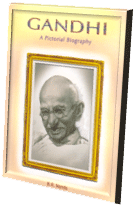
P.O. SEVAGRAM, DIST.WARDHA 442102, MS, INDIA. Phone: 91-7152-284753
FOUNDED BY MAHATMA GANDHI IN 1936
BIOGRAPHY OF GANDHI
GANDHI - A PICTORIAL BIOGRAPHY
by Shri B. R. Nanda

GANDHI
- A PICTORIAL BIOGRAPHY
Shri B. R. Nanda
Table of Contents
- About Gandhi
- Childhood
- Off To England
- Briefless Barrister
- In The 'Dark Continent'
- The Young Politician
- Satyagraha Struggle In South Africa
- The Making Of The Mahatma
- Return To India
- Gandhi's Ashram
- World War I
- Rowlatt Bills
- Nonviolent Non-cooperation
- Arrest And Imprisonment
- Reaction And Recovery
- Declaration Of Complete Independence
- Gandhi-Irwin Pact
- Round Table Conference
- In London
- Resumption Of Struggle
- Campaign Against Untouchability
- A New Deal For The Village
- The New Constitution
- Hindu-Muslim Antagonism
- Nonviolence In A Violent World
- Cripps Mission
- "Quit India"
- Simla Conference
- Cabinet Mission
- Communal Conflagration
- Partition of India
- Mission of Peace
- The End
- Gandhi and Nonviolence
About This Book
This is the first pictorial biography of Gandhi in which the narrative-concise, readable and incisive is illustrated with contemporary photographs and facsimiles of letters, newspaper reports and cartoons, adding up to a fascinating flash-back on the life of Mahatma Gandhi and the struggle for Indian freedom led by him. There is a skilful matching in this book of text and illustrations, of description and analysis and of concrete detail and large perspective. This pictorial biography will revive many memories in those who have lived through the Gandhian era; it should also be of interest to the post-independence generation.
About Author
Shri B. R. Nanda - former Director, Nehru Memorial Museum and Library, New Delhi. His full-scale biography of Mahatma Gandhi has been published in India, Britain and the U.S.A. and translated into French, Spanish, Italian and several other languages
Chapter-30 : Partition of India

The stage was thus set for the June 3 Plan under which power was to be transferred by the British to two successor states on August 15, 1947. What Gandhi has feared had come to pass. India was to be divided, but partition was not being imposed; it had been accepted by Nehru, Patel and a majority of the Congress leaders. Gandhi had serious doubts on the wisdom of this decision. The very violence, which in the opinion of his Congress colleagues and that of the British Government provided a compelling motive for partition was, for him an irresistible argument against it; to accept partition because of the fear of civil war was to acknowledge that "everything was to be got if mad violence was perpetrated in sufficient measure"
Partitions having become a fait accompli, Gandhi's efforts from now on were directed to mitigating its risks. He paid brief visits to Kashmir, the Punjab and Bengal. In Calcutta, just before the transfer of power, his presence had a magical effect; the communal tensions and hatreds of the preceding twelve months vanished almost overnight. When there was a recrudescence of trouble a fortnight later, he went on a fast which electrified the town, moved the Muslims and shamed the Hindus. The leaders of all communities pledged themselves to peace and begged Gandhi to break the fast. The Calcutta fast was rightly acclaimed as a miracle; in the of-quoted words of the London Times, it did what several divisions of troops could not have done.
Gandhi now felt free to turn to Punjab which was witnessing one of the major migrations of population in history. Seized with fantastic hopes and fears, the villages and town of the Punjab had been dreading, and at the same time, preparing for a battle of the barricades. The administrative paralysis caused by the reshuffling of administrative cadres on a communal basis, and the infection of the police and military with communal virus had, by the end of August, led to a situation in which it was impossible for the Hindu minority to stay in West Punjab and the Muslim minority to stay in the East Punjab.
As the interminable caravans of refugees with their tales of woes crawled to their destinations, violence spread. When Gandhi arrived in Delhi early in September, he found it paralysed by communal tension. The Government, led by Nehru, had acted energetically and impartially. Gandhi was not content with a peace imposed by the police and the military; he wanted violence to be purged form the hearts of Hindus and Muslims. It was an uphill task. Delhi had a number of refugee camps, some of which housed Hindus and Sikhs from West Pakistan, while others sheltered Muslims fleeing from Delhi for a passage across the border.